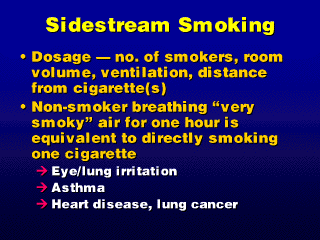 The amount of tobacco smoke in a room is going to be highly
dependent on the box model parameters: source rate, residence time, volume.
In relatively large rooms, like a large restaurant, there may be enough air
exchange between the inside and outside (from people going in and out) that
sidestream smoke concentrations cannot get very high (that does not
reduce the annoyance factor for people near a smoker).
The amount of tobacco smoke in a room is going to be highly
dependent on the box model parameters: source rate, residence time, volume.
In relatively large rooms, like a large restaurant, there may be enough air
exchange between the inside and outside (from people going in and out) that
sidestream smoke concentrations cannot get very high (that does not
reduce the annoyance factor for people near a smoker).
"Very smoky" air contains
enough smoke to make the air look hazy.
The eye/lung irritation and asthma
is from the lachrymators in the tobacco smoke. These include NOx, formaldehyde,
acrolein. Repeated and excessive exposure may eventually lead to chronic bronchitis
and pulmonary emphysema.
Heart disease/increased risk of heart
attack comes from the carbon monoxide (CO). The carbon monoxide reduces the oxygen content
of the blood, which leads to a weakening of the heart muscle.
The increased risk of developing
lung cancer comes from the carcinogens in the tobacco smoke. These include formaldehyde,
nitrosamines, the heavy metals, radioisotopes, and various organic compounds.



 The amount of tobacco smoke in a room is going to be highly
dependent on the box model parameters: source rate, residence time, volume.
In relatively large rooms, like a large restaurant, there may be enough air
exchange between the inside and outside (from people going in and out) that
sidestream smoke concentrations cannot get very high (that does not
reduce the annoyance factor for people near a smoker).
The amount of tobacco smoke in a room is going to be highly
dependent on the box model parameters: source rate, residence time, volume.
In relatively large rooms, like a large restaurant, there may be enough air
exchange between the inside and outside (from people going in and out) that
sidestream smoke concentrations cannot get very high (that does not
reduce the annoyance factor for people near a smoker).